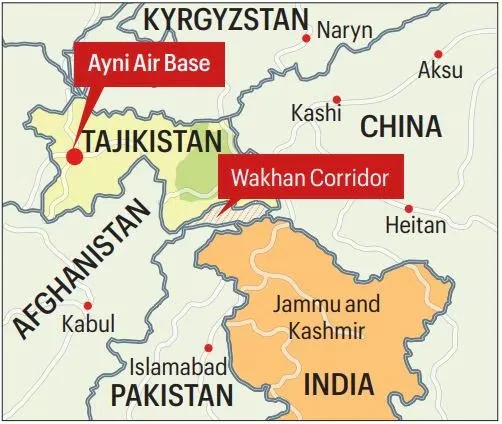Context:
India has recently withdrawn its personnel and equipment from the Ayni airbase in Tajikistan, its only full-fledged overseas military base, which it had developed and maintained for nearly two decades.
About Ayni airbase:
It was a key airbase of India in a strategic location in Tajikistan, where India first deployed military personnel when it was supporting the earlier Northern Alliance in Afghanistan.
· India also used the airbase to evacuate its nationals after the Taliban took control of Kabul in August 2021.
· It is located around 20 km from Afghanistan’s Wakhan Corridor, which shares a boundary with the Pakistan-occupied Kashmir (PoK) and with China’s Xinjiang province.
Reasons for the withdrawal:
The bilateral agreement, in place since 2002 for the "rehabilitation and development" of the aerodrome, expired around 2021-2022 and was not renewed.
Tajikistan government was reluctant to renew the lease for the airbase owing to pressure from Russia and China.
Implication on India:
· Ayni gave India rare air access to Central Asia, a region vital for energy security and counterterrorism.
· Its location near China and Pakistan’s borders offered surveillance and strategic leverage.
· The withdrawal weakens India’s “Connect Central Asia” policy and reduces its operational options after the U.S. exit from Afghanistan.
· It also coincides with China’s expanding presence in the region, including reports of a Chinese base in Tajikistan.
India’s Other Overseas Facilities
· Mauritius (Agaléga): Jointly developed airstrip and jetty (2024).
· Bhutan: Indian Military Training Team (IMTRAT).
· Logistics agreements with France, Oman, Singapore, and Australia offer limited access, not permanent basing.
Way Forward:
· Deepen security ties through SCO and India–Central Asia Dialogue.
· Expand logistics access and enhance air-mobility, space-based surveillance, and maritime reach.
· Balance cooperation with Russia while countering China’s influence via regional partnerships.
Conclusion:
The Ayni exit reflects shifting geopolitical realities and India’s limited capacity for overseas basing. Going forward, India must rely on networked partnerships and strategic agility to sustain influence across Central Asia and the Indian Ocean.







